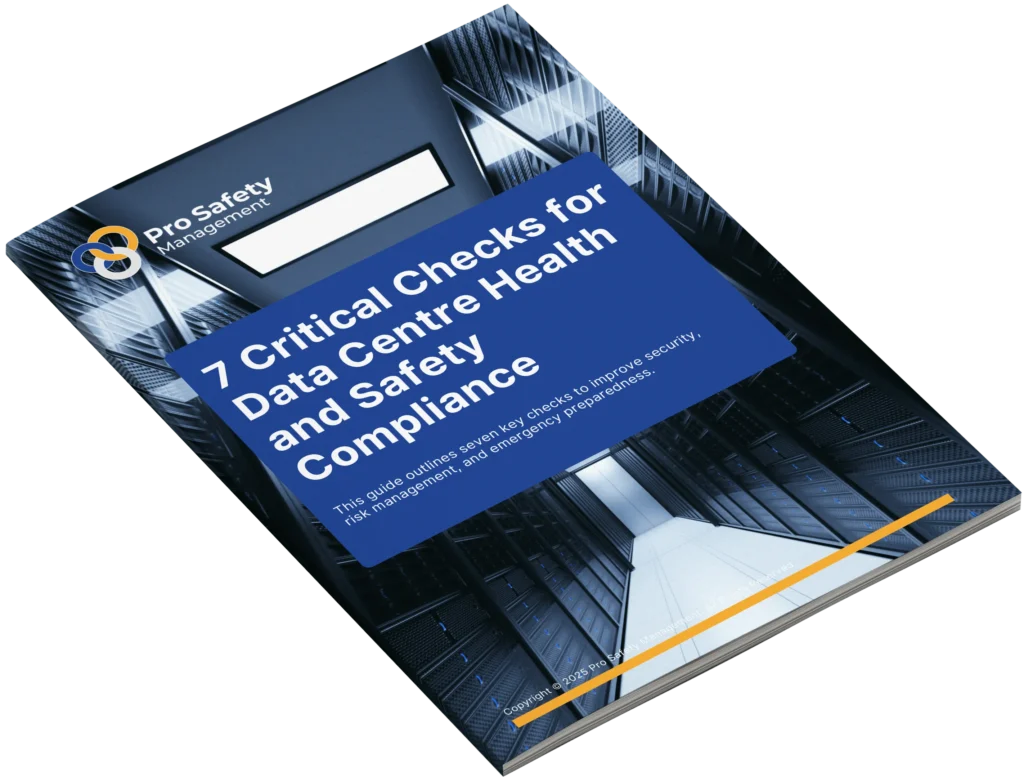7 Critical Checks for Data Centre Health and Safety Compliance
TL;DR:
Ensuring health and safety in data centres is critical to maintaining compliance, protecting workers, and avoiding costly disruptions. This guide outlines seven key checks to improve security, risk management, and emergency preparedness. Download our safety checklist to ensure your data centre meets all essential compliance standards.

Data centres are the backbone of modern digital infrastructure, supporting businesses, government services, and global communications. Ensuring they operate safely is paramount, not just for legal compliance but for the protection of personnel, assets, and business continuity.
Health and safety in data centres is more than a tick-box exercise. It requires stringent protocols, proactive risk management, and clear accountability at every stage of operations. Failing to meet safety standards can result in operational downtime, financial losses, and severe legal consequences.
This guide highlights the seven critical health and safety checks every data centre must implement to maintain compliance and protect its workforce.
For a broader understanding of data centre safety, check out our blog on the 10 key risks in data centres and how you can mitigate them.
Permit Approval: Ensuring Compliance from the Start
Before any work begins, it is essential to obtain all necessary permits, including those for electrical, mechanical, and fire safety work. Regularly reviewing and updating these permits ensures compliance with the latest regulations and prevents costly delays.
Common pitfalls include expired permits, incomplete documentation, or missing regulatory approvals. Keeping a centralised log of all active permits helps maintain efficiency and avoids unnecessary project hold-ups.
Any questions on how to obtain necessary permits? Don’t hesitate to get in touch.
1. Security Protocols: Who’s Getting In and Out?
Security is one of the most critical aspects of data centre safety. Ensuring that only authorised personnel enter restricted areas minimises risks such as data breaches, equipment damage, and workplace injuries.
- Strict access control – Use biometric scanners, access cards, or PIN-protected entry points to monitor movement.
- Thorough background checks – Conduct vetting procedures for all personnel before issuing security clearance.
- Live tracking and monitoring – Implement security surveillance and digital logs to track entries and exits in real time.
A failure in security protocols can lead to unauthorised access, cyber threats, and operational disruptions.
2. Managerial Sign-Off: The Final Green Light
All work within a data centre must be approved by a designated authority, such as the Data Centre Manager or Clerk of Work. Without this step, there is a risk of uncoordinated activity, operational conflicts, and safety breaches.
- Pre-approval of work plans ensures tasks align with the facility’s safety standards.
- Maintaining a formal log of approved work provides accountability and traceability.
- Routine audits help identify any safety gaps or procedural inconsistencies.
By implementing a structured sign-off process, organisations can maintain order and prevent unauthorised modifications to critical infrastructure.
3. Noise Hazards: Protecting Workers in High-Decibel Environments
Data centres can be noisy environments due to the continuous operation of servers, cooling systems, and electrical infrastructure. Long-term exposure to high noise levels can lead to hearing damage and increased stress levels among workers.
- Provide proper PPE – Earplugs or noise-cancelling earmuffs should be mandatory for workers in high-noise zones.
- Regular noise level assessments – Routine monitoring ensures compliance with HSE noise exposure limits.
- Designated quiet zones – Creating rest areas away from machinery helps reduce overall exposure.
Ignoring noise hazards can lead to occupational hearing loss and negatively impact worker concentration and performance.
4. Work Area & Signage: Clear Communication Saves Lives
Clear, well-marked signage and properly structured work areas are fundamental for maintaining safety in data centres.
- Only trained personnel should be responsible for setting up work zones.
- Signage should indicate hazards, restricted areas, and emergency exits clearly and in multiple languages if necessary.
- Temporary barriers should be placed to prevent unauthorised access to active work zones.
Proper signage and well-organised workspaces help prevent accidents, reduce confusion, and improve response times during emergencies.
5. Signage & Barrier Removal: The Job Isn’t Done Until the Site is Clear
Once work is completed, temporary signage and barriers should be removed immediately to avoid misleading workers.
- Final safety inspections should be conducted before reopening the area.
- All outdated hazard warnings must be cleared to prevent confusion.
- A sign-off process should confirm the site is safe for normal operations.
Failure to remove outdated signage can result in unnecessary operational disruptions and safety concerns.
6. Emergency Procedures: When Seconds Matter
Emergencies in data centres require immediate, well-coordinated responses to prevent injury, damage, and operational downtime.
- Establish clear protocols for fire outbreaks, electrical faults, and security breaches.
- Test and maintain emergency systems (alarms, fire suppression units, and backup power sources) regularly.
- Implement a rapid communication strategy via PA systems, mobile alerts, and designated emergency personnel.
Proactive emergency planning ensures faster response times and minimises potential damage.
7. Training & Drills: Keeping Teams Safety-Ready
Regular training and drills are essential to ensure all staff are prepared for real-world safety scenarios.
- Conduct periodic safety drills for fire evacuations, first aid response, and security threats.
- Provide ongoing hazard identification training for both new and existing employees.
- Update training programs regularly based on incident reports, regulatory changes, and emerging risks.
Consistent training creates a culture of safety awareness, ensuring every team member knows their role in protecting themselves and others.
Download Your Data Centre Health & Safety Checklist
Our comprehensive safety checklist helps you to assess your data centre’s health and safety measures.

Interested In a Safer, More Efficient Data Centre Health and Safety Process?
Managing health and safety in data centres is a complex, ongoing task. However, by addressing these 10 key risks and following safety guidelines, you can create a safer environment for both your personnel and the equipment they rely on.
With over 50 years of telecoms expertise, here at Pro Safety Management we are equipped to conduct comprehensive health and safety audits for your data centres, ensuring your facilities operate safely, efficiently, and in full compliance with industry standards.
For more information on how we can support your health and safety needs, visit our Telecoms Health & Safety Services page, or contact us directly below to discuss a tailored audit solution for your data centre.
Get in Touch

Do you want to ensure Health & Safety Compliance?
With over 50 years of telecoms expertise, we are equipped to conduct comprehensive health and safety audits for your data centres, ensuring your facilities operate safely, efficiently, and in full compliance with industry standards.






